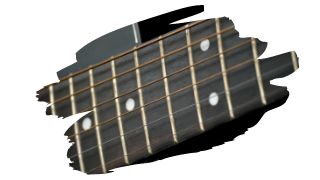You’re likely already familiar with the idea that guitar fretboards need regular cleaning and conditioning.
That’s because all of the oils from your fingertips can start to build up, making a fretboard too sticky to play. Plus, overtime, some unfinished fretboards can easily become parched. So much so, that they reach the point of cracking and splitting.
However, just like with most things in life, there is no one-size-fits-all approach to guitar maintenance.
Some types of wood need more care and attention than others. And when it comes to Amaranth wood in particular, this increasingly popular fretboard is no exception.
So, in this post, you’ll discover why Amaranth is fast replacing Rosewood as the number one wood choice for guitar fretboards. You will also discover the best oil for conditioning Amaranth timber.
And we reveal what you should use to clean a sticky Amaranth fretboard…allowing you to get back to smoothly playing your favourite tunes.

This post may contain affiliate links to products that we receive a commission for (at no additional cost to you). Learn more here.
What Is So Special About An Amaranth Fingerboard?
This unique wood stands out due to its strong violet color.
That is because Amaranth wood is also known as Purpleheart wood, a tropical hardwood that is fairly water-resistant and stable.
It’s rise to fame among guitar makers, comes down to the fact that, this particular hardwood is easier to get a hold of than Rosewood.
You see, Rosewood is becoming increasingly difficult to get a hold of. This is because a 2016 CITES, (Convention On The Trade OF Endangered Species) restriction, put severe limits on the trade of Rosewood lumber.
So, Amaranth fretboards have come in as a more attainable and viable alternative to Rosewood.
Does An Amaranth Fretboard Need Oil?
One of the main differences between Amaranth and Rosewood, (other than their hue), is that Amaranth is not a naturally oily wood.
Rosewood rarely needs oiling or conditioning to prevent it from drying out. That is because this particular hardwood has it’s own natural conditioning oil saturating its grain.
So, adding fretboard oil to Rosewood is rarely required.
Related Post: What Can You Use As A Rosewood Fretboard Finish? (Revealed!)
But, the same can’t be said for Amaranth fretboards. If this purple colored fretboard is left unfinished, it will dry out. And it’ll certainly dry out a lot quicker than Rosewood will.
So, you need to condition Amaranth regularly (certinaly more so than you would Rosewood). But, all of this depends on whether or not an Amaranth fretboard has been finished.
A finished fretboard is one that has had a thin water-resistant permanent sealing coat applied to it. This finishing coat ‘seals’ the surface of that fretboard, safeguarding it from wear and tear.
These finished fretboards don’t need conditioning oils. Besides, any conditioning oil wouldn’t be able to sink past that finishing seal anyway.
What Is The Difference Between Finished And Unfinished Fretboards?
Finished fretboards have been coated with a durable drying oil, or some other lasting moisture-repellent finish.
A drying oil soaks down into wood, coats the grain with a hard resin, and prevents wood from absorbing water. Drying oils will also leave behind a bit of hard film on the surface.
Other finishes, such as nitro lacquer or polyurethane, will simply build up on the surface. But, they too, will form a water-resistant seal on the surface. This seal prevents any conditioning oils from penetrating the grain of a fretboard.
Unfinished fretboards, on the other hand, have no such seal or finish added to them. There is nothing there to prevent water or oils from sinking down into timber.
When it comes to oily woods, such as Rosewood and Ebony, this is fine, since they don’t need much (if any) oil finishes to safeguard them. However, unfinished Amaranth Fretboards are more vulnerable to wear and tear without a sealing finish.
Unfinished fretboards need to be oiled every 6-12 months. However, the aim of oiling them is to simply add a touch of rehydration to wood, not to saturate the grain.
So, they only need a dab of fretboard oil… at least if you don’t want them to end up becoming too oily to play on.
Related Post: What Can You Use As A Fretboard Oil Substitute?
Can You Use Lemon Oil On An Amaranth Fretboard?
Lemon oil is an essential oil that has been squeezed out of the rind of lemons. This stuff is highly acidic, and will eventually go rancid.
On the other hand, the lemon oils sold as fretboard oils, are really just mineral oil. And they have a touch of lemon essential oil drops added for the scent.
So, you can use a lemon scented mineral oil product to condition and rehydrate an Amaranth fretboard. But never (ever) apply pure lemon oil onto your fretboard. The acid will discolor even the deepest purple-hued Amaranth fretboard.
How Do You Condition An Amaranth Fretboard?
If you want to condition a guitar fretboard, then use 100% pure food grade mineral oil. Or, you can use a fretboard oil product that includes pure food grade mineral oil as its main ingredient.
Any other kind of oil, (such as olive oil or some other culinary oil), will go rancid if left to soak into unfinished timber.
Mineral oil, on the other hand, is a highly refined non-toxic version of petroleum. Which means it will never go rancid, and it will never dry.
So, using this non-drying oil is the single best way to rehydrate a faded and worn-down fretboard.
What Is A Non-Drying Oil Exactly?
Non-drying oils, (like Mineral oil), are exactly that…these are oils that never dry out. They do not cure and harden like drying oil, such as Tru-oil or Tung oil.
All non-drying oils do is sink down into the wood grain of a fretboard and rehydrate them. And they leave no build-up behind on the surface.
Will Mineral Oil Clean A Purple Heart Fretboard?
Mineral oil will rehydrate, but it is not a cleaner or a detergent. If you want to clean a sticky purpleheart fretboard, then you need to use a mild solvent called naphtha.
Naphtha will break down oily build-up, enough so that you can remove the grime that’s caused the feeling of stickiness on fretboards.
However, Naphtha should be applied stingily onto a finished fretboard surface. This solution won’t dissolve a finishing sealing coat. But it can soften up Tung oil and Tru-oil finishes if you apply too much of it onto a fretboard.
Related Post: The Top 3 Tru-oil Alternatives That’ll Give Your Guitar A Fine Finish
To Wrap Up, Here Are The 3 Key Takeaways From This Post…
- 1). Amaranth, (also known as Purpleheart wood), is a tropical hardwood that’s increasingly used in lieu of Rosewood.
- 2). An unfinished Amaranth fretboard will need a conditioning application of fretboard oil every 6-12 months.
- 3). Only use pure food grade mineral oil to condition and rehydrate an unfinished Amaranth fretboard.

